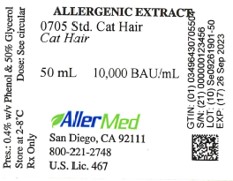Label: STANDARDIZED CAT HAIR- cat hair injection
- NDC Code(s): 49643-705-05, 49643-705-10, 49643-705-30, 49643-705-50
- Packager: Allermed Laboratories, Inc.
- Category: HUMAN PRESCRIPTION DRUG LABEL
- DEA Schedule: None
- Marketing Status: Biologic Licensing Application
Drug Label Information
Updated June 3, 2025
If you are a consumer or patient please visit this version.
- Download DRUG LABEL INFO: PDF XML
- Official Label (Printer Friendly)
-
BOXED WARNING
(What is this?)
WARNINGS
This allergenic product is intended for use by physicians who are experienced in the administration of allergenic extracts and the emergency care of anaphylaxis, or for use under the guidance of an allergy specialist. Standardized Cat Hair Extract is not directly interchangeable with Standardized Cat Pelt Extract or Cat Extracts labeled in Allergy Units (AU/mL) The initial dose must be based on skin testing as described in the dosage and administration section of this insert. Patients being switched from other types of cat extracts to Standardized Cat Hair Extract should be started as though they were coming under treatment for the first time Patients should be instructed to recognize adverse reaction symptoms and cautioned to contact the physicians office if reaction symptoms occur. As with all allergenic extracts, severe systemic reactions may occur. In certain individuals these reactions may result in death.
Patients should be observed for at least 20 minutes following treatment and emergency measures as well as personnel trained in their use should be immediately available in the event of a life threatening reaction.This product should not be injected intravenously (see Dosage and Administration). Refer also to the warnings, precautions, adverse reactions and overdosage sections below.
Serious adverse reactions to this product should be reported to MEDWATCH, Food and Drug Administration, 5600 Fishers Lane, MD 20852-9787. Telephone 1-800-822-7967 or www.vaers.hhs.gov.
Close -
DESCRIPTION
Standardized Cat Hair Extract is a clear, light yellow to amber solution of the allergens of cat hair, extracted in buffered saline containing sodium chloride, sodium bicarbonate and 50% glycerol ...
-
CLINICAL PHARMACOLOGY
Positive skin tests with allergenic extract are the result of histamine release from mast cells sensitized with allergen specific IgE. The exact mechanisms by which immunotherapy relieves symptoms ...
-
INDICATIONS AND USAGE
Studies have shown that skin tests with cat extract are useful in the diagnosis of cat allergy. As a rule, persons with cat allergy have positive skin reactions when tested with cat extract, and ...
-
CONTRAINDICATIONS
Standardized Cat Hair Extract should not be used for immunotherapy in persons who do not have cat related allergic symptoms and a positive skin test to the extract.
-
WARNINGS
Standardized Cat Hair Extract may cause local or severe life-threatening reactions when administered to highly sensitive individuals. Physicians who use this product should be familiar with the ...
-
PRECAUTIONS
GENERAL: Do not inject intravenously. After the needle is inserted subcutaneously, the plunger should be withdrawn slightly to check for the presence of blood in the syringe If blood is observed ...
-
ADVERSE REACTIONS
Local Reactions From Skin Testing - Large local reactions may result from skin tests with Standardized Cat Hair Extract. To help prevent this, a patient should be skin tested initially by the ...
-
OVERDOSAGE
Severe generalized symptoms or anaphylaxis following an injection must be treated immediately with Epinephrine HCL 1:1,000 as follows: Usual Dosage-Infants under 2 years 0.05 to 0.1 cc; children ...
-
DOSAGE AND ADMINISTRATION
Diagnosis: Concentrated extract (10,000 BAU/mL) may be used for scratch or prick-puncture testing. Puncture tests performed with a bifurcated needle in ten cat allergic persons showed a mean ...
-
HOW SUPPLIED
Standardized Cat Hair Extract containing 10,000 BAU per mL is supplied in 5 mL dropper vials for scratch or prick testing and in 10 mL, 30 mL and 50 mL vials as concentrate.
-
STORAGE AND HANDLING
Extract should be stored at 2°C to 8°C since higher temperatures may adversely affect stability. Do not freeze.
-
REFERENCES
1. Ohman, J.L. Studies of the origin and environmental occurrence of cat allergen. J. Allergy Clin. Immunol., 69:127, 1982. 2. Anderson, M.G., and Baer, H.. Allergenically active components of ...
-
PRINCIPAL DISPLAY PANEL

-
INGREDIENTS AND APPEARANCEProduct Information

